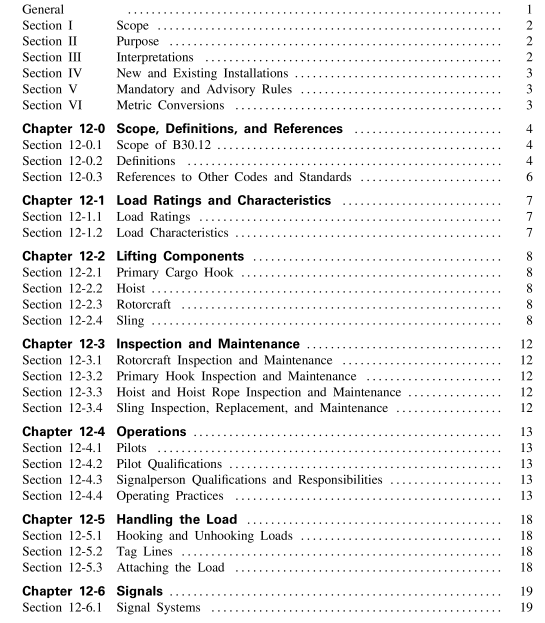ASME B30.12:2001 pdf free download HANDLING LOADS SUSPENDED FROM ROTORCRAFT
This Volume applies to the protection of flight crews,ground personnel, and property on the surface whileworking directly with or in the vicinity of rotorcraftconducting external load operations. Within the generalscope as defined in Section I, B30.12 applies to the han-dling of loads suspended from rotorcraft using a cargosling or powered hoist, or other attaching means, to lift,carry, pull,or tow a jettisonable load outside of therotorcraft airframe.
SECTION 12-0.2:DEFINITIONS
12-0.2.1 Rotorcraft External Load ClassificationsClass A Rotorcraft External Load: a load combination inwhich the external load cannot move freely, cannot bejettisoned, and does not extend below the landing gear.This category usually features multiple attachments tothe airframe.A typical example is a hard-mounted cargobasket attached to the rotorcraft airframe that is usedto carry cargo from points A to B(included for referenceonly).
Class B Rotorcraft External Load: a load combination inwhich the external load is jettisonable and lifted free ofland or water during the rotorcraft operation. The loadis typically suspended from a hook or similar device.The hook may be attached to the rotorcraft structure, orit may be attached to a movable hoist cable and the hoistitself attached to the rotorcraft. Typical use is to lift acargo load until it is completely airborne and fly it frompoints A to B.
Class C Roforcraft External Load: a load combination inwhich the external load is jettisonable and remains incontact with land or water during rotorcraft operation.The load is typically in contact with land or water duringrotorcraft operation.The load is typically partially sus-pended by a net, slings, or cables from a cargo hook orsimilar device.The cargo hook may be attached to therotorcraft structure or a movable hoist cable and thehoist itself attached to the rotorcraft. It is typically usedfor stringing wire or laying cable where the load is par-tially suspended from the ground.
Class D Roforcraft External Load: a load combination inwhich the external load is other than a Class A, B, or Cand has been specifically approved by the Administratorfor that operation. This load combination includeshuman cargo. For human cargo operations,the load,which typically consists of personnel and their contain-ment device, is suspended from a hook or similar deviceduring all or part of the flight. The hook may be attachedto a movable hoist cable and the hoist itself rigidlyattached to the rotorcraft. Typical use is for transfer ofpersonnel to / from a ship. Carrying devices may trans-port one or more persons.Typical carrying devices arevest and straps, baskets, life preservers with straps andattachment devices, cages, or a suspended container.
12-0.2.2 General Definitions
administrative or regulatory authority: governmental
agency or the employer in the absence of governmentaljurisdiction.
adninistrator: the Federal Aviation Administrator or anyperson to whom he has delegated his authority in thematter concerned.
aircraft: a device that is used or intended to be used forflight in the air.
airfranme: the fuselage, booms,nacelles,cowlings, fair-ings, airfoil surfaces (including rotors but excluding pro-pellers and rotating airfoils of engines),and landinggear of an aircraft and their accessories and controls.altitude, AGL: the height of a level, point, or object mea-sured in feet Above Ground Level (AGL).
altitude, MSL: the height of a level, point, or object mea-sured in feet from Mean Sea Level (MSL).
apex fitting: a ring or attaching device between the hookand sling and the supporting cables to the load.
appointed: assigned specific responsibilities by theemployer or the employer’s representative.
attitude: the position of the rotorcraft or suspended loadwith reference to a horizontal position, such as nose upor down.
ASME B30.12:2001 pdf free download
